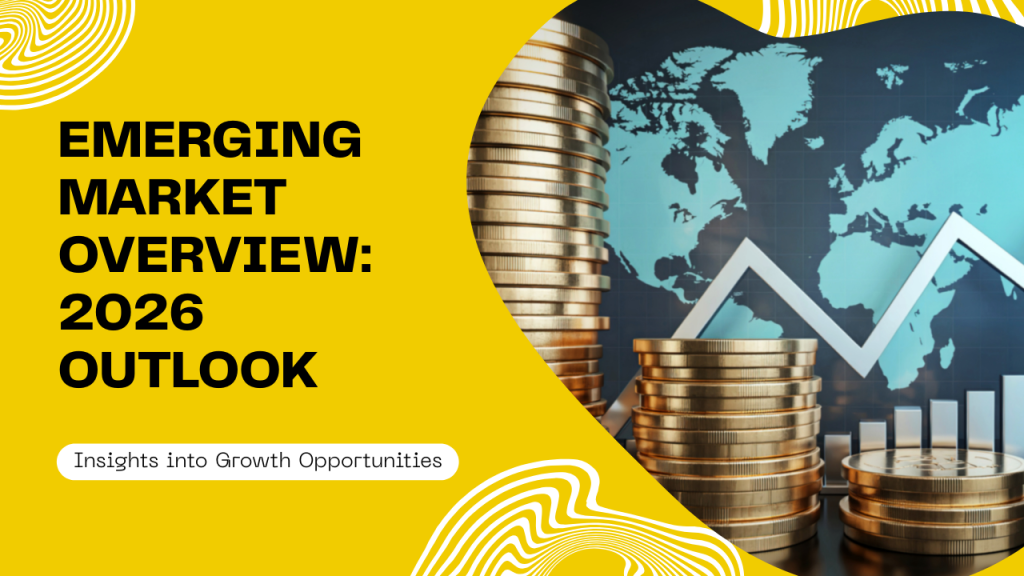
Introduction: Entering 2026 with Divergence in Emerging Markets
The year 2026 will likely mark a turning point for emerging markets (EM). While global investors remain cautious about geopolitical risks and slowing growth in advanced economies, EM assets are positioned for selective outperformance. The overarching narrative is divergence — between regions, sectors, and asset classes.
Three forces will shape the 2026 EM landscape:
- Global Monetary Shifts: The U.S. Federal Reserve is expected to transition toward gradual easing, reducing pressure on EM currencies and capital flows.
- Structural Growth Drivers: Demographics, digital transformation, and green energy investment remain long-term strengths.
- Geopolitical Realignment: The U.S.–China rivalry, supply chain diversification, and regional security dynamics will continue to reshape EM investment strategies.
Macro Backdrop for EM in 2026
Global Growth Context
- Advanced economies: ~1.5% GDP growth forecast.
- Emerging markets: ~4.5% GDP growth forecast.
- India remains the fastest-growing large economy (>6%), while China stabilizes around 4%.
Inflation and Rates
- Global disinflation continues, though food and energy volatility persists.
- EM central banks are expected to maintain cautious stances, but some room for rate cuts appears.
Capital Flows
- Risk appetite is returning as global yields peak.
- EM equity and bond inflows expected to rise by 15–20% year-over-year.
- ESG flows reaccelerate, particularly into green infrastructure.
EM Differentiation in 2026
Winners
- India & Mexico: Demographics, nearshoring, and policy reforms.
- Indonesia & Vietnam: Critical players in global supply chain diversification.
- Chile & Peru: Commodity exporters positioned for energy transition.
Challengers
- China: Still critical but faces property and debt overhang.
- Turkey & Argentina: Volatility high despite periodic stabilization.
Frontier Opportunities
- Africa (Nigeria, Kenya, Egypt): Long-term demographics, but short-term macro challenges.
- GCC (Saudi Arabia, UAE, Qatar): Stability, fiscal surpluses, global investment footprints.
Key Investment Themes for 2026
- Nearshoring & Supply Chain Diversification
- Mexico, Vietnam, and India are central to this trend.
- Energy Transition Supercycle
- Copper, lithium, and nickel remain essential, favoring Chile, Peru, and Indonesia.
- Digital & Financial Inclusion
- EM fintech adoption surges, especially in Africa and South Asia.
- Demographics & Consumption
- Young populations in India, Nigeria, and Southeast Asia drive structural demand.
Mid-Year Insights (Interim Outlook for 2026)
- EM growth to remain nearly 3x that of developed markets.
- Selective EM currencies may rally if Fed easing materializes.
- Equity valuations attractive relative to DM, but dispersion is high.
- Commodities remain strategic allocations for inflation hedging.
Regional Breakdown for 2026
Asia
- India: Continues as global growth engine, >6% GDP. Structural reforms and digital finance adoption attract FDI.
- China: Slower growth (~4%), but selective opportunities in green energy and advanced manufacturing.
- Indonesia & Vietnam: Winners from supply chain shifts, rising role in EV and electronics.
Latin America
- Mexico: Benefits from U.S. nearshoring and industrial investment.
- Brazil: Commodity exports and agribusiness, but fiscal noise continues.
- Chile & Peru: Copper/lithium exports vital for global energy transition.
EMEA
- South Africa: Commodity-linked but governance concerns persist.
- Turkey: Stabilization attempts continue, inflation risk elevated.
- GCC: Remain fiscal anchors, sovereign wealth funds deploy capital globally.
Risk Scenarios in 2026
- Hard Landing in Advanced Economies
- Would suppress EM exports and capital inflows.
- Resurgent Inflation
- Commodity shocks could force EM central banks to tighten again.
- Geopolitical Escalations
- U.S.–China tensions, Middle East instability, and Russia–Ukraine conflict remain watchpoints.
- Climate & ESG Disruptions
- Extreme weather events could impact agriculture and supply chains.
Investment Strategy Recommendations
- Equities:
- Overweight India, Mexico, Indonesia.
- Selective plays in China (green tech, advanced manufacturing).
- Bonds:
- EM local debt attractive with potential Fed easing.
- Focus on high real yielders (Brazil, South Africa, Mexico).
- FX & Carry Trades:
- MXN, INR, IDR remain top carry currencies.
- KRW stable, tactical opportunities in Asia.
- Commodities:
- Strategic allocation to copper, lithium, and agriculture.
- Thematic Opportunities:
- ESG-linked bonds, green infrastructure, fintech adoption in Africa and Asia.
Final Outlook for 2026
Emerging markets are set to outperform developed peers in 2026, but dispersion is the key theme. Investors should adopt a barbell strategy — balancing structural winners like India, Mexico, and Indonesia with tactical exposure to commodities and selective bond markets.
Leave a Reply